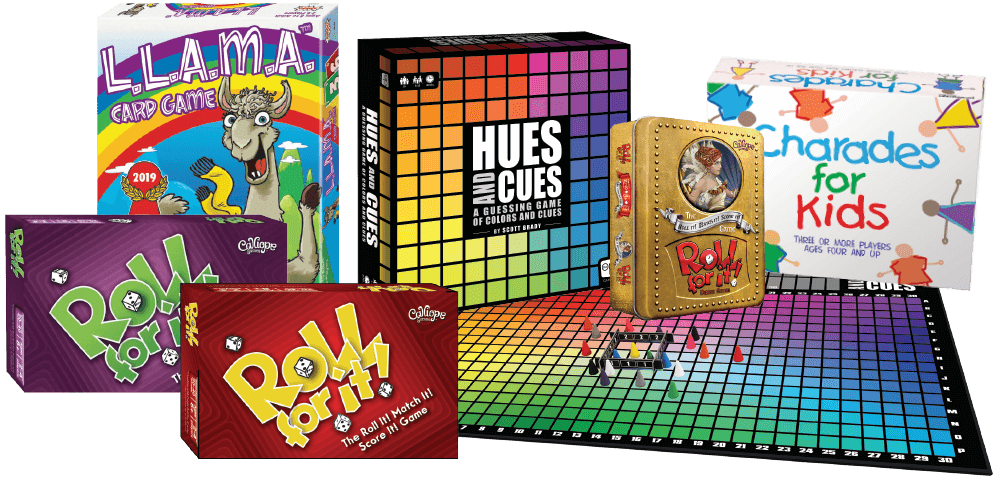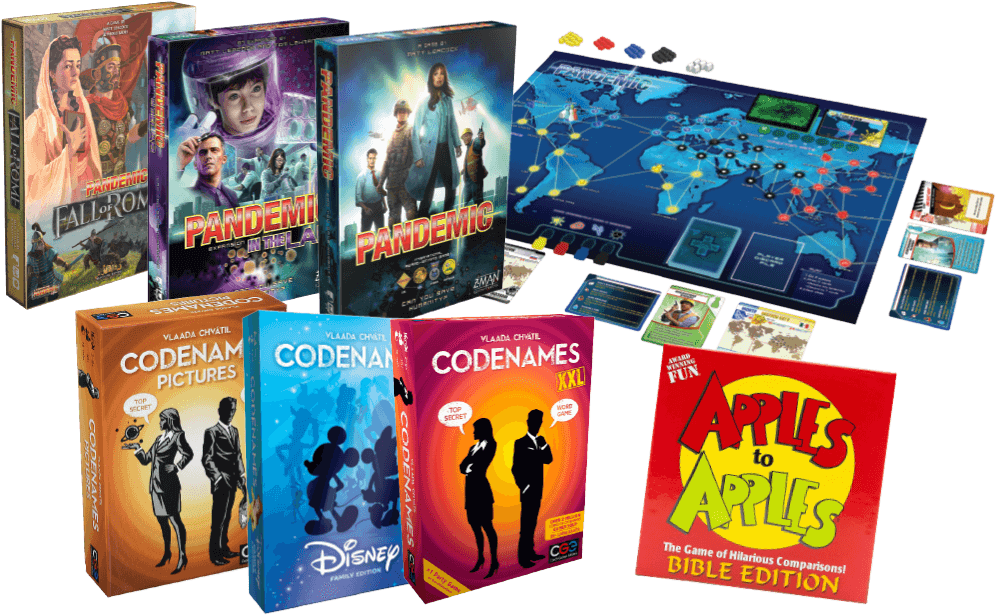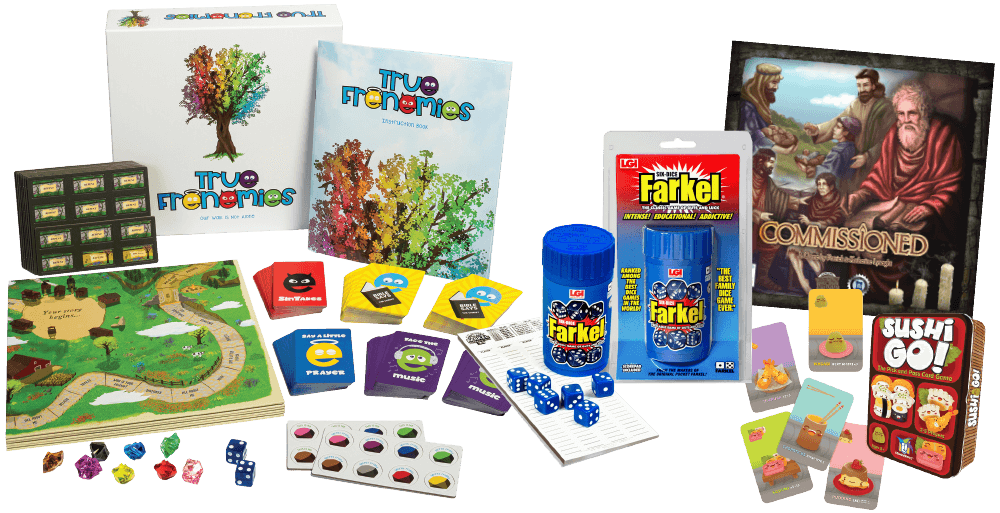
Deanne Crawford & Gina Burmeier
you are ready to create memories with your family and loved ones, what better way than an enjoyable family game? Spending time around the table with a good game builds relationships, teaches kids good sportsmanship, and gets the whole family away from the screen to laugh and have fun together. Your kids will always remember these times and, hopefully, carry on these traditions in their own families.
The holidays are a time for food, faith, and fellowship. Keeping those elements in mind, we’re excited to share some of our favorite games to help you create a memorable holiday for your whole family!
We have several engaging family games larger crowds will enjoy.
Roll for it by Calliope Games is a fast-paced, family-friendly game for ages eight to adult. This is a card and dice game all in one. Cards have dice images on them in different combinations along with point values. To begin play, each player chooses their dice color, shuffles the cards, and places three cards face-up in the middle of the table. Each player rolls two of their dice and the player with the higher number goes first. On your turn, roll all your dice, and place those that match any of the dice images next to the card it matches. You only get one roll on your turn, so if you have dice that don’t match, take them back and the next person rolls. When you match all the numbers on a card, it’s yours! Collect enough cards to equal forty points and you win the game.
Game play is about twenty minutes and there are different versions. The red edition has translucent dice in purple, yellow, red, and turquoise; the purple edition has pearl dice in blue, green, red, and white. The deluxe edition comes in a beautiful tin and includes two decks of cards, forty-eight dice in eight colors to use with two to eight players.

Hues and Cues by USAopoly is another fun family game for ages eight and up that can be played with three to ten players. This game challenges players to describe or guess a certain shade of color. The player describing the hue draws a card with four color swatches on it, along with the grid location for those colors on the board. With 480 hues to pick from, players give one-word clues such as “dandelion” or “seaweed” to try to identify the exact color being described. All the other players place a pawn on a colored space. Then the describing player has the chance to give a two-word clue and other players place their second pawns. Points are awarded based on how close players get to the actual color. Game time is approximately thirty minutes.
Fellowship-friendly games create cooperation and bonding. For a game that can be enjoyed by younger children too, Charades for Kids by Pressman Toy is a great option. The game is composed of 150 cards, each with three clues for a total of 450 charades, a die, and a timer. One clue is colorfully illustrated on the card so even non-readers can take a turn acting. Others roll the die to see which clue they will portray. Some example words include baseball bat, lasso, and rain. First player to guess three clues is the winner!

Pandemic by Z-Man Games is a cooperative strategy game for two to four players for ages thirteen and up. The goal is to work together with your team to research cures for four different diseases and keep the outbreak from spreading. Players build research stations across the globe to try and find a cure. Outbreaks, cures, and how fast the disease is spreading are all tracked. Game play starts with nine cities being infected. On each player’s turn, they can perform up to four actions (move to a different city, build research stations, treat diseases, and share knowledge), draw two player cards, and infect cities. The team to discover a cure for all four diseases first wins the game. There are several expansion sets to add on to the original game for different variations of the game. Pandemic On the Brink adds a fifth unique disease to the game. Pandemic The Fall of Rome takes you back to the Roman empire. In the Lab adds even more variety and challenge. Play time is about forty-five to sixty minutes on average.
As Christian homeschoolers, sharing and instilling Godly faith and character comes from our very core. It is why we get up every day and press on, even when we don’t feel it. Playing games is an effective way to help our children see faith in action. Friendly competitiveness, respect and honor, and how we win or lose are all valuable skills to share through real-life experience. But take your faith sharing to the next level with a Christian-themed game.
Apples to Apples Bible Edition from Cactus Game Design, reinvents this popular and hilarious party game to focus on the Bible and Christian history. If you are not familiar with the original game, play is straightforward and easy for children eight years and up to learn. The game consists of red apple cards and green apple cards. The red apple cards all contain nouns from the Bible or Christian history, and a Bible verse is featured on the bottom of each card. In the first round, one player is elected the judge, and that person deals out seven cards to each player including himself. The judge flips over a green adjective card. Each player, except the judge, plays a red noun card face down that he feels best fits that adjective. The judge shuffles the cards (so he won’t know who played which card), reads through them, decides which card is the best fit (or the funniest, depending on the judge), and awards the green apple card to that player. Then the player on the left of the judge becomes the next judge, who replenishes everyone’s hand to seven cards, and the second round begins. The first player to gather four green apple cards wins! Designed for four to ten players, this game is perfect for family get-togethers or youth activities.
True Frenemies from Mount 21 Productions provides another unique and fun way to share your faith. Reminiscent of Pilgrim’s Progress, this detailed game guides you through life and the steps needed to come to faith. Historically accurate, and beautifully illustrated, the goal is to be the first to reach the tree of life, bringing one other player with you. Sounds simple right? The challenge is that you cannot reveal or “give away” who you are trying to help—even to that person. Game play focuses on “roll and move” with the twist that every time it is your turn, you can move yourself forward, anyone else forward, or any other player backward. With these simple choices as well as the unique requirement to covertly help another player who may be assisting someone else while sabotaging you, the timing element in the final stages may be mind-bending as you try to figure out the win requirements for all players at the table and exit at just the right moment.
Sound complicated? The same could be said of our Christian walk! The layers of depth are designed to teach and entertain, a unique winning combination for our family. True Frenemies includes 120 Bible Says cards detailing the life and message of Jesus, forty Sin Takes cards which will have an immediate benefit but then carry a cost for most of the rest of the game, forty Say a Little Prayer cards which may or may not work out as you intend, as well as the eighty Face the Music cards which are truth or dare in concept and may be quite humorous or very serious.

Each game begins by selecting one of five scenario cards, each of those with specific tasks and special rules. Players begin in a single city with a small but growing church membership in the region based on the selected scenario. Each round, players draw “faith cards” (representing their apostle’s works), face trials (such as false teachers, who prevent the growth of the church), pray (select faith cards to help the church), share their advice on which cards to play, move to a new city, grow the church, and mature (acquire new faith cards). This process continues until the victory condition is met and all players win, or five cities’ churches have been “extinguished,” in which case they lose. A unique way to experience the trials of the early church in a game format. Includes an appendix which explains some of the historical background and biblical citations.
What if one of your family members isn’t thrilled with game playing? It is a reality for many of us. Deanne’s husband is a reluctant gamer unless it is a pure chance game (like Farkel).
A fun, flavorful way to entice reluctant gamers is to center game play around food. Serve popcorn, pretzels, or carrot and celery sticks. You can also tempt their palates with food-centered games. Sushi-Go from Gamewright is quickly becoming a family favorite. In this fast-paced game, the goal is to collect the best sushi dinner. Players choose their favorite sushi dish from their hand, place it in front of them, and then pass the rest of the hand to the next player. Once all the cards are chosen, the round is over, and the sushi is scored. Score the most points by dipping your nigiri in wasabi, collecting three sashimi, piling on the dumplings, or having the most maki rolls, and don’t forget to save some pudding for dessert!

Game play with little ones is essential and so often overlooked in the myriad of choices for family fun games. Sure, we can play educational games with our littles to teach the letters of the alphabet, numbers, counting and the like, but sometimes they just want to have fun too!
Check out Acorn Soup from MW Wholesale. Any child who can recognize numbers or count from one to three will love following the pictorial recipe cards in Acorn Soup to make their own special soup. Use the spoon to add each playing piece (acorn, berries, clover, and more) to the storage box—I mean soup pot—and stir, stir, stir. When that soup is cooked, make another until three soups are made. Includes eight recipe cards (5½” x 4”), twenty-four wooden ingredients (from 1½” to 2½”), and one (2”x 7”) wooden spoon. And I know I said fun games without an educational purpose, but games weave casual learning with skill development! Creative thinking, fine and gross motor skills, counting skills, number recognition, and matching and sorting skills are all part of the fun!
The holiday season is the perfect time to gather around the table and build a strong family bond with an enjoyable game. Spending quality time together will create lots of laughter and lasting memories for years to come. You may also inspire the next generation of family gamers!
